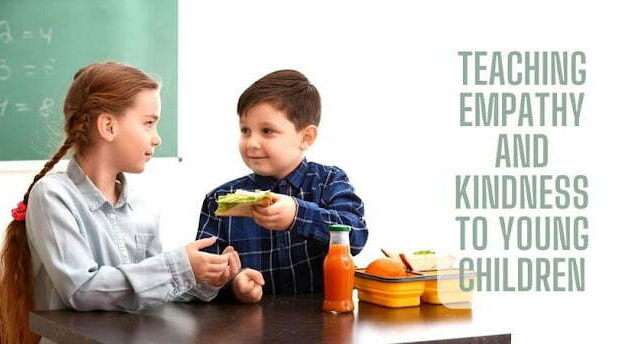Empathy is the ability to understand and share the feelings of others, while kindness is the act of being considerate and compassionate towards others. In today’s world, where there is so much negativity and hatred, it’s more important than ever to teach our children the value of empathy and kindness.
It is an essential trait that enables us to connect with others and build strong relationships. Teaching empathy to young children can help them develop important social skills and build healthy relationships. Here are some key aspects of empathy development in children:
Empathy involves not only recognizing and understanding other people’s emotions but also being able to respond to them appropriately. It is a complex emotional response that requires both cognitive and affective processing.
Stages of Empathy Development in Children
Empathy development in children occurs in several stages, which include:
1. Early infancy
In the first few months of life, infants begin to respond to others’ emotions, primarily by mimicking facial expressions.
2. 6 months to 2 years
At this stage, children start to experience emotional contagion, which means they can sense and react to the emotions of those around them. They also start to show rudimentary signs of empathy, such as comforting others who are upset.
3. 2 to 6 years
During this period, children’s empathy skills begin to develop more rapidly. They start to understand that other people have thoughts and feelings that are different from their own, and they become more skilled at recognizing and labeling emotions.
4. 6 to 9 years
At this stage, children begin to develop a more nuanced understanding of emotions. They can recognize and respond to more complex emotions, such as disappointment, jealousy, and empathy. They also become more aware of social norms and rules.
5. 9 to 12 years
During this final stage, children become increasingly skilled at taking other people’s perspectives and showing empathy. They can identify and regulate their own emotions more effectively, and they can recognize and respond to the emotions of others in a more nuanced way.
Understanding the stages of empathy development in children can help parents and caregivers teach empathy in ways that are developmentally appropriate and effective.
The Benefits of Empathy and Kindness
Empathy and kindness are essential traits that can help children build healthy relationships and navigate the world around them. Here are some of the benefits of teaching empathy and kindness to young children:
1. Positive effects on relationships
- Empathetic children tend to be better communicators and listeners, which can lead to stronger and more fulfilling relationships with others.
- Kindness is contagious, and when children learn to be kind to others, they are more likely to receive kindness in return.
2. Improved emotional well-being
Emotional intelligence is the ability to understand and manage one’s own emotions and the emotions of others. When children learn empathy and kindness, they develop emotional intelligence, which is crucial for their social and emotional development.
- Empathy and kindness can help children develop a sense of self-worth and self-esteem, which can contribute to improved emotional well-being.
- Being kind to others can also give children a sense of purpose and fulfillment, which can help them develop a positive outlook on life.
3. Success in future endeavors
- Empathy and kindness are important skills for success in many areas of life, including school, work, and personal relationships.
- Children who learn to be empathetic and kind are more likely to be successful in their future endeavors because they are able to work well with others and build strong, supportive relationships.
Strategies for Teaching Empathy and Kindness to Young Children
Teaching empathy and kindness to young children may seem challenging, but it can be done effectively with the right strategies. Here are some strategies that parents, caregivers, and educators can use to help children develop empathy and kindness:
1. Lead by example
Children learn by observing the behavior of the adults around them. By modeling empathy and kindness in your own behavior, you can teach children the importance of treating others with respect and understanding.
2. Encourage perspective-taking
Help children to understand the perspectives and feelings of others by asking them to imagine what it might be like to be in another person’s shoes. Encourage them to consider how their actions might affect others and to think about the feelings of others before acting.
3. Use age-appropriate language and scenarios
Children’s understanding of empathy and kindness will vary depending on their age and developmental stage. Use age-appropriate language and scenarios to help children understand these concepts.
4. Practice gratitude and appreciation
Encourage children to express gratitude and appreciation for the people and things in their lives. This can help them to develop a sense of empathy and compassion for others.
5. Emphasize the value of differences
Teach children to appreciate and value the differences between themselves and others. Encourage them to celebrate diversity and to respect others who may have different backgrounds, beliefs, or abilities.
By using these strategies, parents, caregivers, and educators can help children to develop empathy and kindness, which are essential skills for building positive relationships and contributing to a better world.
Incorporating Empathy and Kindness in Everyday Life
It’s essential to make empathy and kindness a part of everyday life to help children develop a natural inclination towards it. Here are some ways to incorporate empathy and kindness in daily life:
1. Reinforcing positive behaviors and language
- Children learn from positive reinforcement, so it’s crucial to recognize and acknowledge their empathetic and kind actions.
- Encourage them to use kind words and gestures towards others, such as saying please and thank you, holding the door open, or sharing toys.
2. Avoiding negative or hurtful comments and actions
- Be mindful of your words and actions around children, and avoid using negative or hurtful language, even in jest.
- If a child exhibits negative behavior, address it calmly and firmly, emphasizing how it affects others.
3. Celebrating acts of kindness and compassion
- Celebrate and acknowledge kind acts, such as sharing, helping others, and showing compassion.
- Encourage children to identify situations where they can be kind and empathetic towards others.
By incorporating empathy and kindness in everyday life, children can develop these traits as a natural part of their behavior, leading to a more compassionate and inclusive society.
The Role of Parents and Caregivers
As parents and caregivers, you play a critical role in shaping your child’s understanding and practice of empathy and kindness. Here are some ways you can help:
1. Modeling empathy and kindness
Children learn by observing the behavior of the people around them, particularly the adults in their lives. By modeling empathy and kindness, you are demonstrating the importance and value of these qualities.
- Show empathy and kindness towards others, especially when your child is present.
- Use positive language when talking about others, even when you disagree or have differences.
- Acknowledge and apologize for any unkind or hurtful behavior you display towards others.
2. Encouraging and reinforcing positive behaviors
It’s important to reinforce positive behavior and encourage your child to engage in acts of kindness and empathy.
- Praise your child when they exhibit kind behavior towards others.
- Encourage your child to engage in cooperative play and teamwork.
- Teach your child to respect the feelings of others and to be mindful of their words and actions.
3. Creating a safe and inclusive environment
Creating a safe and inclusive environment is key to promoting empathy and kindness in your child.
- Encourage your child to share their feelings and thoughts with you in a safe and non-judgmental space.
- Teach your child to appreciate and value differences in others.
- Create opportunities for your child to interact with diverse groups of people, cultures, and communities.
By incorporating these strategies into your parenting and caregiving practices, you can help your child develop a strong sense of empathy and kindness, which will serve them well throughout their lives.
Conclusion
Teaching empathy and kindness to young children is crucial in today’s world. Children who learn how to empathize and be kind are better equipped to navigate social situations and build strong relationships throughout their lives. To summarize, the key points to consider when teaching empathy and kindness to young children include:
- Defining empathy: Empathy is the ability to understand and share the feelings of others. It involves putting oneself in someone else’s shoes and imagining how they might feel in a given situation.
- Stages of empathy development: Children develop empathy in stages, beginning with simply being aware of others’ emotions and progressing to being able to take the perspective of others and offer comfort and support.
- Benefits of empathy and kindness: Empathy and kindness can have a positive impact on relationships, emotional well-being, and future success.
- Strategies for teaching empathy and kindness: Parents and caregivers can lead by example, encourage perspective-taking, use age-appropriate language and scenarios, practice gratitude and appreciation, and emphasize the value of differences.
- Incorporating empathy and kindness in everyday life: Reinforcing positive behaviors and language, avoiding negative or hurtful comments and actions, and celebrating acts of kindness and compassion can help children develop and practice empathy and kindness.
- The role of parents and caregivers: Modeling empathy and kindness, encouraging and reinforcing positive behaviors, and creating a safe and inclusive environment are all important roles that parents and caregivers play in teaching empathy and kindness to young children.
In conclusion, teaching empathy and kindness to young children is essential in building a kinder, more compassionate world. By instilling these values early on, we can help our children become more empathetic, understanding, and compassionate individuals who can make a positive impact on the world around them.


